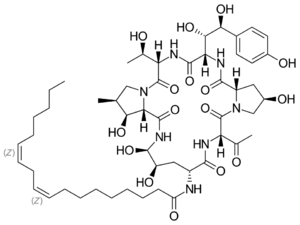Chemistry:Echinocandin B

| |
| Names | |
|---|---|
| IUPAC name
(9Z,12Z)-N-{(2R,6S,9R,11R,12R,14aS,16R,20S,23S,25aS)-23-[(1S,2S)-1,2-Dihydroxy-2-(4-hydroxyphenyl)ethyl]-2,11,12-trihydroxy-6,20-bis[(1R)-1-hydroxyethyl]-16-methyl-5,8,14,19,22,25-hexaoxotetracosahydro-1H-dipyrrolo[2,1-c:2',1'-l] [1,4,7,10,13,16]hexaazacyclohenicosin-9-yl}-9,12-octadecadienamide
| |
| Identifiers | |
3D model (JSmol)
|
|
| ChemSpider | |
| MeSH | echinocandin+B |
PubChem CID
|
|
| UNII | |
| |
| |
| Properties | |
| C52H81N7O16 | |
| Molar mass | 1060.24 g/mol |
Except where otherwise noted, data are given for materials in their standard state (at 25 °C [77 °F], 100 kPa). | |
| Infobox references | |
Echinocandin B, a lipopeptide, is a naturally occurring cyclic hexapeptide with a linoleoyl side chain. It belongs to a class of antifungal agents called echinocandins, which inhibits the synthesis of glucan, a major component of the fungal cell wall, via noncompetitive inhibition of a crucial enzyme, β-(1→3)-D-glucan synthase. Echinocandin B is a fermentation product of Aspergillus nidulans and the closely related species, A. rugulosus;[1] discovered in 1974 in A. nidulans var. echinulatus strain A 32204 in Germany,[2] it was the first of the echinocandin class of antifungals.
Echinocandin B can undergo deacylation (removal of the lipid side chain) by the action of a deacylase enzyme from the filamentous bacterium Actinoplanes utahensis, which catalyzes the cleavage of the linoleoyl side chain;[3] in three subsequent synthetic steps, including a chemical reacylation, the antifungal drug anidulafungin is synthesized.[4]
References
- ↑ Denning DW (1997). "Echinocandins and pneumocandins - a new antifungal class with a novel mode of action". J Antimicrob Chemother 40 (5): 611–614. doi:10.1093/jac/dkf045. PMID 9421307.
- ↑ "Metabolites of microorganisms. 143. Echinocandin B, a novel polypeptide-antibiotic from Aspergillus nidulans var. echinulatus: isolation and structural components". Helv Chim Acta 57 (8): 2459–2477. 1974. doi:10.1002/hlca.19740570818. PMID 4613708.
- ↑ Lei Shao; Jian Li; Aijuan Liu; Qing Chang; Huimin Lin; Daijie Chen (2013). "Efficient Bioconversion of Echinocandin B to Its Nucleus by Overexpression of Deacylase Genes in Different Host Strains". Applied and Environmental Microbiology 79 (4): 1126–1133. doi:10.1128/AEM.02792-12. PMID 23220968. Bibcode: 2013ApEnM..79.1126S.
- ↑ "Anidulafungin EMA Europa". http://www.ema.europa.eu/docs/en_GB/document_library/EPAR_-_Scientific_Discussion/human/000788/WC500020676.pdf.
External links
 |

